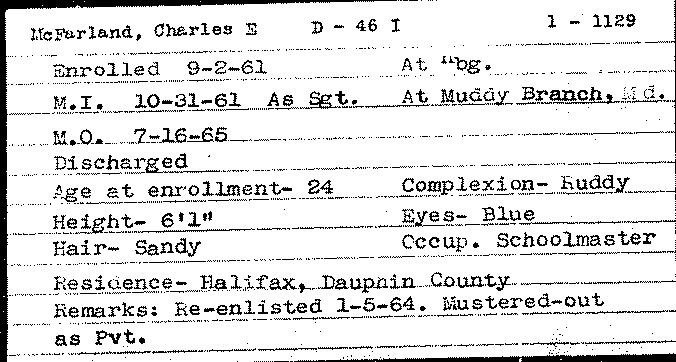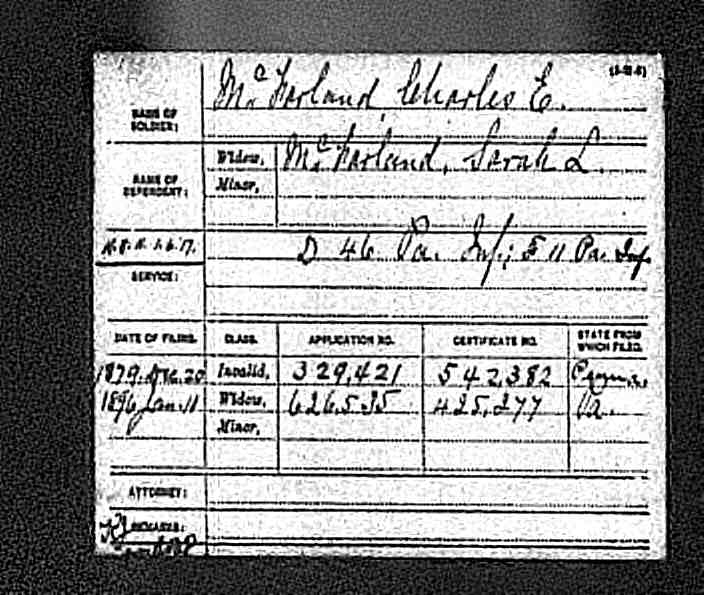Charles E. McFarland – White Supremacist, 1866
Posted By Norman Gasbarro on July 23, 2018
During the Civil War, Charles E. McFarland, served in the 46th Pennsylvania Infantry, Company D, as a Private. He was a teacher from Halifax Township, and is buried at Halifax United Methodist Church Cemetery, Halifax, Dauphin County, Pennsylvania.
According to his Pennsylvania Veterans’ File Card from the Pennsylvania Archives, Charles E. McFarland enrolled in the 46th Pennsylvania Infantry on 2 September 1861, and was mustered into service at Muddy Branch, Maryland, as a Sergeant on 31 October 1861. At the time he was 24 years old, stood 6 foot 1 inch in height, had sandy hair, a ruddy complexion, and blue eyes. He gave his residence as Halifax and his occupation as schoolmaster. He re-enlisted on 5 January 1864 and was mustered out on 16 July 1865 as a Private. There is no indication on the card as to why he was demoted in rank.
At the beginning of the Civil War, he married Sarah L. Brubaker (1839-1914) and with her had at least nine known children, two of whom (twin girls) were born about 1862 while he was in the army and the remainder born after he was honorably discharged.
As a result of this Civil War service, Charles E. McFarland applied for an received an invalid pension, 20 December 1879, from Pennsylvania. The widow, Sarah L. McFarland, applied after his death from Virginia.
Previously on this blog, the following posts mentioned Charles E. McFarland: Civil War Burials in the Halifax United Methodist Church Cemetery (Part 4 of 5); 46th Pennsylvania Infantry – Pennsylvania Memorial at Gettysburg; and Halifax Area Civil War Veterans.
After the war, Charles E. McFarland openly supported the white supremacist views of Heister Clymer by signing a call for denial of equal rights to African Americans, both those who were previously slaves and those who were previously freemen. The statement was published in the Harrisburg Patriot of 24 July 1866 and included his name, regiment, company and rank.
Heister Clymer was a white supremacist candidate for Pennsylvania Governor on the Democratic Party ticket in 1866, and was previously profiled here on 26 April 2016.
The call for a meeting of Union Soldiers was printed in the Harrisburg Patriot, 24 July 1866, along with an up-to-date list of Clymer supporters who openly supported Heister Clymer‘s white supremacist views and wanted to deny “negro equality and suffrage” even to those who had been free men before the war.
The undersigned honorably discharged Union soldiers, believing that we battled in the late war for the Union of these States, and had successfully maintained it, view with alarm the persistent efforts of radical men who seem determine, practically to destroy the Union we went forth to save. They would have the community believe that Union soldiers are willing to give up in the hour of victory the great object to which their sacrifices and toll and blood were given….
Therefore we unite in requesting all the honorably discharged officer, soldiers and seamen of Dauphin County who favor the wise and constitutional policy of President Johnson, who oppose the doctrine of negro equality and suffrage, and desire the election of the Hon. Hiester Clymer, to meet in Mass Convention at the Democratic Club Room, Walnut Street, below Third, Harrisburg, at 7 1/2 o’clock, on the evening of the 25 July 1866, for the purpose of electing fourteen delegates to the Convention of Union Soldiers, which is to assemble in this city [Harrisburg] on Wednesday, 1 August 1866.
The Dauphin County veterans who signed the racist petition calling for the meeting were from a variety of regiments and social levels. Included in the list were some residents of Upper Dauphin County, the area north of Peter’s Mountain – all of which is included in the geographic area of the Civil War Research Project.
Charles E. McFarland was only one of many honorably discharged Union soldiers who openly supported the white supremacist gubernatorial campaign of Heister Clymer in 1866. The full list of those with a connection to Upper Dauphin County will be presented over time.
 ;
;





Comments